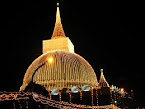The historical person we know as the Buddha was an Indian prince of the Sakya people living in North India. He renounced the right to the throne, became a religious seeker early in his life and then after reaching enlightenment he became a spiritual teacher. His given name was SIDDHARTHA and his clan name was GOTAMA. He was not called the Buddha in his early years, but acquired this designation only in his 35th year after he attained enlightenment.
The word Buddha is not simply a title given to one particular individual, but it is a designation given to a kind of individual. It represents not a single unique person, but a type of person. Only one Buddha can appear in any historical period. But throughout the cycles of world evolution, there have been many Buddhas appearing one at a time separated by vast intervals. Siddhartha Gotama is only the most recent Buddha and there will be many more Buddhas to come.
According to Buddhist teachings the physical universe has countless world systems with many planes of existence (e.g. heavenly, human, animal etc.). In all those planes, life is subject to impermanence, to arising and passing away, to birth, growth, ageing and passing away. Due to impermanence, existence is seen to be fundamentally unsatisfactory and subject to suffering.
Outside the phenomenal universe there exists another state, an unconditional state, a state of perfect bliss, of unfading peace. This state is called NIBBANA in Pali.
Also there exists a path, a way which leads from one state to another, from theimpermanence and suffering of the round of becoming to the bliss and peace of NIBBANA.This is the Noble Eightfold Path.
In the history of any particular world system there will be a time when this path isknown and followed, there will be people who practice the path and who reach theattainment of Nibbana. But inevitably there comes a time when that path falls into neglectand the knowledge of the path fades from people's minds until the path disappears andbecomes lost. Then follows a period of spiritual darkness. This could be a period ofmillions of years, of many eons.
Eventually there arises a being, a man who by his own innate wisdom, by his ownstriving and energy, without any guide or teacher, rediscovers that lost path todeliverance. Having rediscovered the path, he follows it to the end, he reaches theattainment of Nibbana, and then out of compassion for others who are afflicted bysuffering he comes back to proclaim that path, to make it known again to the world. Aperson who accomplishes this twofold task of rediscovering the path and making it knownagain to the world is called a Buddha.
The Buddha always comes as a human being. He begins like us, caught up in the round ofsuffering. However he is not an ordinary man. He is an extraordinary man. With immensepotential of intelligence, energy, and compassion which he has developed through countlesslifetimes of self-cultivation he has prepared himself for his future role as a Buddha byperfecting in himself the qualities, the virtues, the powers required of a world teacher.By making the path known to the world, Buddha opens the road to deliverance for allhumanity so that others can follow the path and reach liberation.










0 comments:
Post a Comment